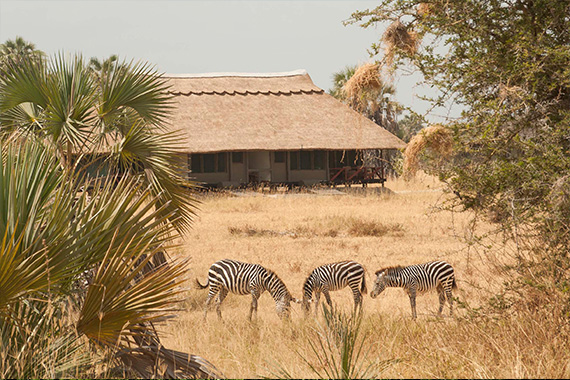From its Rift Valley soda lake to dense woodlands and high mountainsides, Lake Manyara National Park offers a wilderness experience in varied environments. Apart from a spectacular setting, the park is famous for its unusual tree-climbing lions and the vast elephant herds it was established to protect.
The lake’s shores, which are encrusted with pink flamingos, attract over 400 species of birds, many of which are waterfowl or migrants. Buffalo, cheetah, Masai giraffe, and impala roam the lakeshores and forested valley slopes in large herds.
With approximately 178,473 annual visitors, a Lake Manyara safari is an enthralling experience as the park includes a ground-water forest, acacia tortilis woodland, and Maji Moto hot springs. Hundreds of olive baboons appear alongside Sykes monkeys and short-eared galagos. Other park residents include the Cape clawless otter, Egyptian mongoose, hippo, and klipspringer.

BEST TIME TO VISIT MANYARA NATIONAL PARK
The best time to see wildlife in Lake Manyara National Park is from late June to October when the weather is dry. However, during the Wet season, from April to May, when the foliage is lush and waterfalls cascade down the escarpment, this incredibly magnificent park is at its most beautiful.
June To October
- Animals can be spotted more easily in the shorter grass.
- There is a lot of sun and very little rain, so there is less chance of getting malaria because there are fewer mosquitos.
- Bring warm clothing in June and August because it can be cold in the mornings.

April To May
- The surroundings are lush and green.
- Because April and May are low seasons, it is usually less crowded and has lower rates.
- Although wildlife is easier to spot during the dry season, Lake Manyara National Park provides excellent wildlife viewing all year.
- This is the best time to go bird watching because migratory birds can be found.
- Rains may make it difficult to travel on roads.
- The Wet season lasts from late March to May.

PLACES TO STAY AT MANYARA NATIONAL PARK
Accommodation at Lake Manyara varies by location, but by using an XPATS International three-tier expectation system, costs and experiences remain consistent. For example, in Manyara, there are only a few second-tier camps.
Camps
A premium luxury tier 1 experience at Lake Manyara provides excellent amenities for visitors seeking an authentic East African under canvas safari experience of an intimate and exclusive nature, with a high standard of personal service and a minimal ecological footprint, even if this means foregoing many high modern luxuries. Wildlife can be found within feet of your sleeping tent. Cooking in the bush is done over a charcoal fire. Outback entertainment consists of flame visuals over a traditional campfire accompanied by nice chats. There’s no in-tent internet (only in public areas) or hair dryers, while smokey washing water is heated over a wood fire and delivered in buckets to a primitive bush shower head.
Tier 2 level, on the other hand, is modest and private outside the park, adjacent to the main road and nearby town. The facilities in the tents offer continual hot and cold running water, and a variety of activities are available, including horseback riding, fly camping, hide watching, and more.

Lodges
Manyara lodges are graded using the same system, but they are permanent structures made of brick, stone, and other indigenous materials with a central reception, lounge, bar, and dining area. Tier 1 Lake Manyara Lodges, are spectacular concepts. They are situated in unique settings and are striking in design. In a forest of mahogany trees, ten quiet, roomy cottages are erected on stilts. On the second tier, some northern Tanzania travel hotels overlooking the national park are positioned on the rim of the Rift Valley escarpment. There are a few simple lodges on a third, more budget-conscious level — Tier 3 – with less personal service and flexibility.
Manyara lodges are graded using the same system, but they are permanent structures made of brick, stone, and other indigenous materials with a central reception, lounge, bar, and dining area. Tier 1 Lake Manyara Lodges, are spectacular concepts. They are situated in unique settings and are striking in design. In a forest of mahogany trees, ten quiet, roomy cottages are erected on stilts.
On the second tier, located on the rim of the Rift Valley escarpment, are northern Tanzania travel hotels overlooking the national park. These are commonly sixteen-room hotels with chandeliers and leather furniture.
Lastly, a few simple lodges on a third, more budget-conscious level — Tier 3 – with less personal service and flexibility are available. These low-cost lodges command a truly spectacular location, providing clean and comfortable lodging as well as modest scenic views and a variety of activities.

WAYS TO EXPERIENCE MANYARA NATIONAL PARK
When you’re ready to begin planning your safari vacation, you can choose from a variety of safari packages designed to help you experience the Manyara Ecosystem in style. Manyara National Park’s most popular wildlife safari packages include 7-day standard safaris in Tanzania, 6-day traditional Tanzania safari tours, and 5-day safari game drives. Because these are low-cost safari tours, expect to see a variety of safari destinations in the northern circuit, such as Tarangire National Park, the Serengeti, the Ngorongoro Crater, and Lake Manyara. The parks of northern Tanzania are among the most beautiful places to visit on an African safari.

WAYS TO GET TO MANYARA NATIONAL PARK
The majority of Manyara safaris depart and return to Arusha. Fly into Arusha’s Kilimanjaro International Airport (JRO), which is approximately 46 kilometers/29 miles away. It is also possible to fly into Dar es Salaam’s Julius Nyerere International Airport (DAR) and then to Arusha Airport (ARK) or Kilimanjaro International Airport (KLI) (JRO).

Flights from Arusha to the park’s various airstrips are scheduled on a regular basis. Driving is another option. The journey will take approximately eight hours and cover approximately 325 kilometers (202 miles). It’s a bumpy ride, but it’s beautiful, and there’s a chance you’ll see some wildlife.



